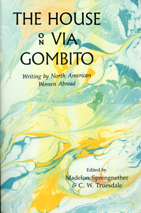All the bridges in Venice are pedestrian–it’s a city without cars. Yet, the map shows only a few–the Rialto and the huge bridge crossing the Grand Canal before the railroad station. But how do people get across? I asked myself, studying the map in the months before I arrived. Donna Leon’s mystery novels suggest all kinds of sprinting, sauntering, skulking. Surely there must be bridges.
The approach to the city over water from the Marco Polo airport is the most romantic I’ve ever experienced–misty, flat and watery–with the Alilaguna “motoscaffo” (great Italian word suggesting the motor part and escape) twisting around striped poles to avoid the shallows. Cormorants and gulls bobbed or soared overhead. I could have been a teen again, speeding down the Inland Waterway between wild green barrier islands south of home, Charleston, South Carolina. The same excitement of entering a watery world at a speed to put wind in your face.
The same anticipation of discovery that could plunge deep and lift into the air. Then we slowed for Murano, the huge glass-factory island, a village in itself; passed the cemetery island girded with its retrained necklace of pink and white walls below a colony of tall green cypress, and found the city itself.
I was tired and excited and a bit unsteady on my feet. With my insistent map-gazing, I’d determined that my little hotel Boccassini lay close to this northern rim of the city, but which direction from the dock? Someone pointed and said in Italian, “over two bridges.” Each bridge was like an arched hand over a narrow strip of water; each had thin “steps” which required me to lift my little suitcase on its rollers, trudge to the next and lift. Many of the wider and steeper bridges did the same, but by then, I’d ditched my suitcase and taken a nap.
Here are somethings I discovered about canals and bridges. For good walking, choose a long sidewalk beside a canal. My favorite was Fondamenta dei Mendicanti, which I found by crossing another bridge along the rim of the lagoon and turning into the heart of the city. For the Venetians, “Fondamenta” means a wide paved “front” or foundation to the water. It’s not the same as a “Riva,” which is a much wider paved space, such as the Riva degli Schiavoni, along the Grand Canal leading toward San Marco. When I left my little hotel in its warren of crazy-making narrow streets, and found myself again on the Fondamenta Nova along the lagoon, then turned onto Fondamenta dei Mendicanti (that last word refers to beggars) I soon felt as if I might not get lost for quite a while.
This was true in part because I soon walked into what in other Italian cities would be called a piazza, but which in Venice is a campo or field. This one, Campo Santi Giavanni e Paolo (Saints John and Paul) shared its name with a wonderful building, once a church, now a huge hospital. When Napoleon deconsecrated enormous numbers of churches in the early 1800s, many immediately took on other uses. In the campo before this truly unusual building, with two half-moon atop its facade, I discovered amazing bas reliefs arranged beside the door. The image at the start of this blog is the second image. It’s of men in turbans–Venice was after all linked closely with what we’d call the near east. It’s no doubt an image from the Bible, though I’d be the last to guess, well ok I’ll guess Joseph and his brothers.
In any case, passing the ospedale, pausing each time I passed to and fro toward the innards of Venice and more twists and turns and dead ends against walls and bridges that ended in private doors, each time passing, I would pay homage to the former church, its elegant facade opening into the campo and the astonishing images. In my next entry on Venice, I’ll give you the other image, a lion forward of a long colonnade into the background. Another mystery of this amazing city.


Leave a Reply